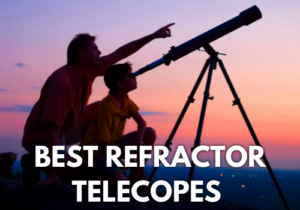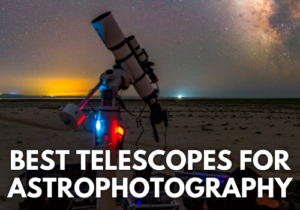
Best Telescope For Adults 2025; Reviews
Disclosure: This post contains affiliate links and I may earn a small commission (at no extra cost to you) if you click through and make a purchase. Thanks in advance – I really appreciate it!
Here in this “Best Telescope For Adults” article we’ve rounded up 12 of the best telescopes of various types, specifications, and budget perfectly suited for a beginner adult or someone looking to level up from their existing telescope. Below, you’ll find in-depth reviews of each, as well as an elaborate buying guide to help you pick out the one that suits you the most.
COMPARISON TABLE
| Image | Title | Best For | Features | Price | Buy |
|---|---|---|---|---|---|
Top Top
Top
Top
Top
Top
Top Top
Top
Top
Top
Top
Top | Celestron - PowerSeeker 127EQ | Best For Beginner | Type: Reflector, Aperture: 127 mm(5″), Focal length: 1000mm, Focal Ratio: f/8 | See on Amazon | |
 Top
Top
Top
Top
Top
Top
Top
Top
Top
Top | Celestron - AstroMaster 130EQ | Best Under $300 | Type: Reflector, Aperture: 130 mm(5.1″), Focal length: 650mm, Focal Ratio: f/5 | See on Amazon | |
 Top
Top
Top
Top | Orion SkyQuest XT6 PLUS Dobsonian | Best Dobsonian | Type: Reflector, Aperture: 150mm (6″), Focal length: 1200mm | See on Amazon | |
 Top
Top
Top
Top
Top
Top
Top
Top
Top
Top | Orion 09007 SpaceProbe 130ST | Best Reflector | Type: Reflector, Aperture: 130 mm(5.1″), Focal length: 650mm, Focal Ratio: f/5 | See on Amazon | |
 Top
Top
Top
Top
Top
Top
Top
Top
Top
Top | Celestron - NexStar 5SE | Best GoTo | Type: Schmidt-Cassegrain, Aperture: 125mm (5″), Focal length: 1250mm, Focal Ratio: f/10 | See on Amazon | |
 Top
Top
Top
Top
Top
Top
Top
Top
Top
Top | Orion StarBlast II 4.5 Equatorial Reflector | Best For the Moon | Type: Reflector, Aperture: 114mm (4.5″), Focal length: 450mm, Focal Ratio: f/4 | See on Amazon | |
 Top
Top
Top
Top
Top
Top
Top
Top
Top
Top | Sky-Watcher Flextube 200 Dobsonian 8-inch | Best For DSOs | Type: Newtonian Reflector, Aperture: 203mm (8”), Focal length: 1200mm, Focal Ratio: f/6 | See on Amazon | |
 Top
Top
Top
Top
Top
Top
Top
Top
Top
Top | Celestron - 70mm Travel Scope | Best Portable Pick | Type: Reflector, Aperture: 70mm (2.8″), Focal length: 400mm, Focal Ratio: f/5.7 | See on Amazon | |
 Top
Top
Top
Top
Top
Top
Top
Top
Top
Top | Celestron - NexStar 127SLT | Best For Astrophgotography | Type: Schmidt-Cassegrain, Aperture: 127mm (5″), Focal length: 1500mm, Focal Ratio: f/12 | See on Amazon | |
 Top
Top
Top
Top
Top
Top
Top
Top
Top
Top | Celestron - 114LCM | Best For Planets & Galaxies | Type: Reflector, Aperture: 114 mm(4.5″), Focal length: 1000mm, Focal Ratio: f/8.8 | See on Amazon | |
 Top
Top
Top
Top
Top
Top
Top
Top
Top
Top | Gskyer Telescope | Best Refractor | Type: Refractor, Aperture: 90mm(3.5”), Focal length: 600mm, Focal Ratio: f/6.7 | See on Amazon |
Product prices and availability are accurate as of the date/time indicated and are subject to change. Any price and availability information displayed on [relevant Amazon Site(s), as applicable] at the time of purchase will apply to the purchase of this product.
Prices pulled from the Amazon Product Advertising API on:Are you an adult looking for a telescope so you can watch and observe the nightsky from the comfort of your home or to take the telescope with you to your favorite stargazing location. Then we assure you – you have landed on the right page and we will assist you in finding your best telescope for adults that you can use by yourself or along with your family and friends to fulfill your love for astronomy.
Since there are so many options available in the market today, we did a survey among fellow astronomy enthusiasts, and consulted 3 of our in-house experts and came up with a list of 12 best telescopes perfectly suitable for adults.
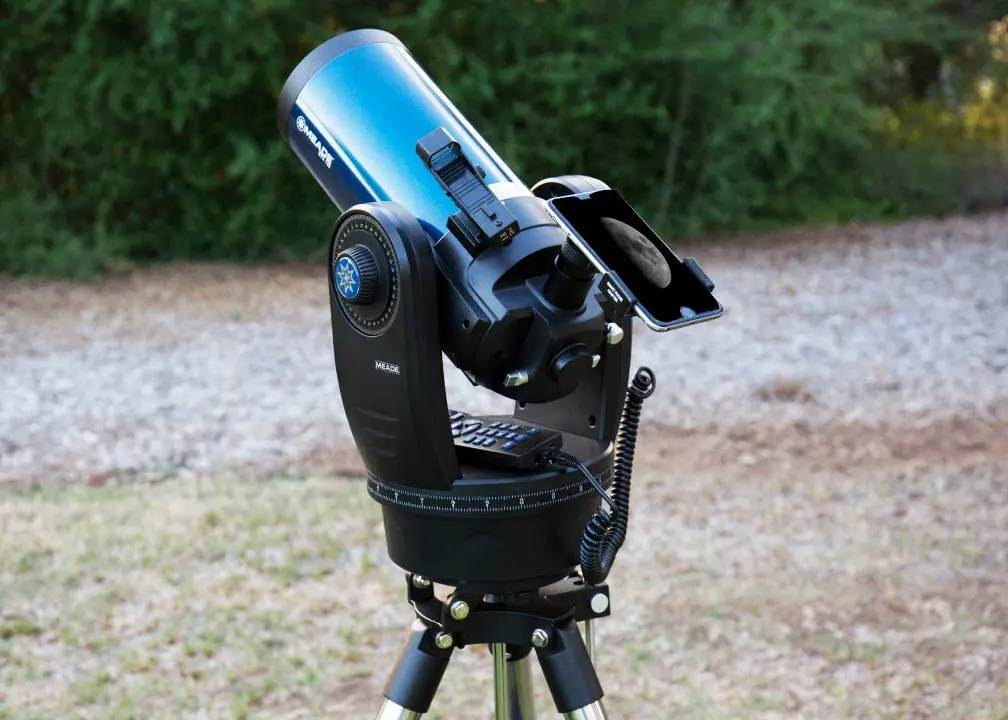
Best Telescope For Adults
Best For Beginner Adults
Celestron – PowerSeeker 127EQ
- Type: Reflector
- Aperture: 127 mm(5″)
- Focal length: 1000mm
- Focal Ratio: f/8
- Mount: German Equatorial
- Eyepiece: 20mm, 4mm
- Magnification: 50x, 250x
- Weight: 22.0 lbs.(10.0 kg)
- Our Rating: 9/10
Prices pulled from the Amazon Product Advertising API on:
Product prices and availability are accurate as of the date/time indicated and are subject to change. Any price and availability information displayed on [relevant Amazon Site(s), as applicable] at the time of purchase will apply to the purchase of this product.
The Celestron PowerSeeker 127EQ telescope is a Newtonian reflector, which means it uses mirrors to gather the light of the skies, and reflects it for viewing. With mirrors being much less expensive to produce than glass lenses, reflector telescopes offer more value in terms of inches of aperture.
The PowerSeeker 127EQ comes with two eyepieces (4mm and 20mm) and a 3x Barlow lens.
The 5-inch mirror on the 127mm PowerSeeker model limits useful magnification to about 250x, which is achieved using the 4mm eyepiece.
The larger 20mm eyepiece provides a more useful 50x magnification. This grows to 150x when coupled with the 3x Barlow.
If you’re considering an additional eyepiece, something like a 15mm Plossi would be a good option. This provides you with 66x magnification, or 198 when coupled with the Barlow.
The telescope is ideal for near and deep-sky observation, Celestron’s PowerSeeker 127EQ 127mm f/8 Reflector Telescope features a respectable focal length and a large, parabolic mirror that produce detailed images of the Moon, clear views of the planets, and the ability to resolve bright distant objects such as nebulae and galaxies.
The beauty of a Newtonian telescope is the longer focal lengths which can be offered in much shorter tube sizes—1000mm focal length in a tube which is only 20 inches (508mm) long .
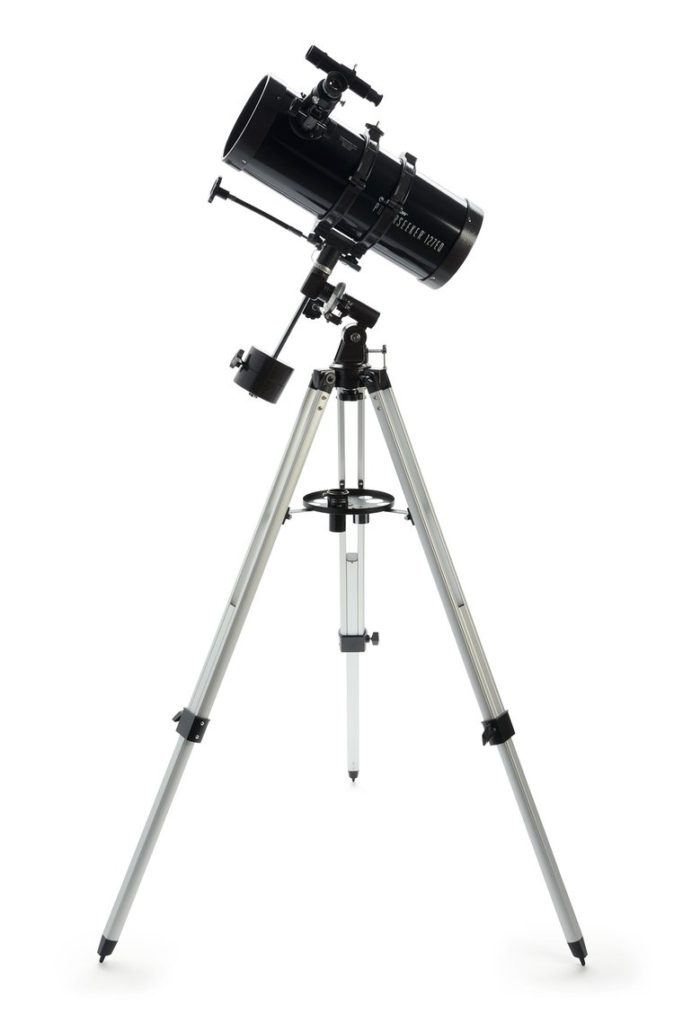
The PowerSeeker 127EQ is highly portable and one of the best telescopes for adults under $500. You could easily fit this telescope and tripod in the trunk of a car and still have room for your other equipment, or maybe a late night picnic.
Additionally, you receive a copy of Starry Night astronomy software with a database of over 10,000 celestial objects.
Considering the telescope’s low price, compromises had to be made, and one such compromise is the use of a spherical mirror rather than a parabolic mirror.
Optical aberrations tend to be more common with spherical mirrors. This telescope does, however, feature an erect image diagonal for the right way up images, which prevents some aberration.
This telescope comes with an Equatorial mount, designed for astronomy telescopes. Included are two manual slow-motion controls, these allow for smoother tracking of objects as they pass across the night sky.
The tripod is made of aluminum, although lightweight, it is robust, solid and also comes with a very handy accessory tray which lets you keep extra eyepieces and T-rings for a camera, close to hand.
Pros:
- Solid build quality
- Stable mount
- Comes with a 3x Barlow lens
Cons:
- Spherical mirror leads to some amount of aberrations
- Occasional collimation of the mirrors required
Best Under $300
Celestron – AstroMaster 130EQ
- Type: Reflector
- Aperture: 130 mm(5.1″)
- Focal length: 650mm
- Focal Ratio: f/5
- Mount: Equatorial
- Eyepiece: 20mm, 10mm
- Magnification: 32.5x, 65x
- Weight: 28.0 lbs.(12.7 kg)
- Our Rating: 9.2/10
Prices pulled from the Amazon Product Advertising API on:
Product prices and availability are accurate as of the date/time indicated and are subject to change. Any price and availability information displayed on [relevant Amazon Site(s), as applicable] at the time of purchase will apply to the purchase of this product.
The telescope is fitted with a 1.25 rack-and-pinion focuser and two eyepieces to get new users started – a 10mm that yields 65x power and a 20mm for a 32.5x magnification.
The 20mm eyepiece integrates an erecting system to correct images horizontally and vertically to allow easy terrestrial use.
The AstroMaster 130EQ also features an unmagnified red-dot finder to help set-up, align and navigate easier.
Celestron’s AstroMaster 130EQ 130mm f/5 Reflector Telescope features a 650mm focal length and an oversized parabolic mirror that produce detailed images of the Moon, clear views of the planets, and the ability to resolve distant objects such as nebulae and galaxies.
The 130EQ comes on a lightweight German equatorial mount that works well enough for the 130 mm f/5 OTA, and it should work okay with a DSLR camera piggybacked on top.
Since it can get quite hard to keep the object in the view because of the Earth’s rotation, there is an upgrade for this mount to help you with that.
It is a simple clock motor which you turn on after you get the object in the view and it will track the object keeping it in the middle of the eyepiece. It’s much easier to stargaze like this rather than twisting the knobs while looking through the eyepiece. The motor is not included but it can be bought separately.
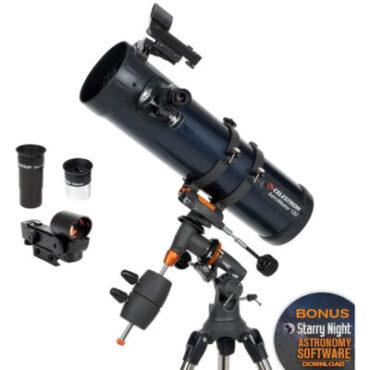
The Celestron’s AstroMaster 130EQ is one of the best budget telescopes for adults as not only is it great for planetary viewing, with the moons of Jupiter and rings of Saturn being star attractions, but being a reflector telescope with a wide aperture, it could be one of the cheapest telescopes on offer that can decently display deep space objects.
At just 17 lbs total weight and thanks to its compact design, the Celestron AstroMaster 130 EQ is very portable. You can take it literally everywhere with you, unlike heavier and bulkier telescopes for professional use.
Pros:
- Very good optics
- Decently priced telescope
- Suitable for beginners as well as advanced users
- Clear crisp mirrors
Cons:
- Focuser is of limited usability
- No filters included
Related
Best Dobsonian
Orion SkyQuest XT6 Plus
- An upgraded XT6 Classic Dobsonian with performance-boosting design enhancements and additional accessories
- Redesigned base with adjustable altitude tension supports the attractive twilight blue optical tube
- Easy, tool-free collimation adjustment thanks to knurled secondary mirror thumbscrews
- Aperture: 150mm (6″)
- Focal length: 1200mm
- Focal Ratio: f/8
- Eyepiece: 25mm, 10mm
- Magnification: 48x, 120x
Prices pulled from the Amazon Product Advertising API on:
Product prices and availability are accurate as of the date/time indicated and are subject to change. Any price and availability information displayed on [relevant Amazon Site(s), as applicable] at the time of purchase will apply to the purchase of this product.
The Orion SkyQuest XT6 Plus Dobsonian Telescope has been one of the favorite Dobsonian telescopes for many beginner adult astronomy enthusiasts. It’s sleek, user-friendly with sharp, powerful optics and point-and-view simplicity.
The scope is manufactured by Orion Telescopes & Binoculars which is one of the best telescope brands in the world. They have been around since 1975 because of their quality products and great value.
They have a great range of telescopes and accessories for telescopes that are suitable for all age ranges and experience levels.
The beautiful, eye-catching Orion SkyQuest XT6 Plus 6” Dobsonian Telescope is a must have if you are looking for a good telescope to see planets and galaxies.
The Orion SkyQuest XT6 Plus is an upgraded version of XT6 Classic Dobsonian with performance-boosting design enhancements and additional accessories.
SkyQuest XT6 Plus has a redesigned Dobsonian base with a sleeker, more streamlined look. The scope features weight-saving cutouts in the side panels that help make the base easier to move to and from observing sites.
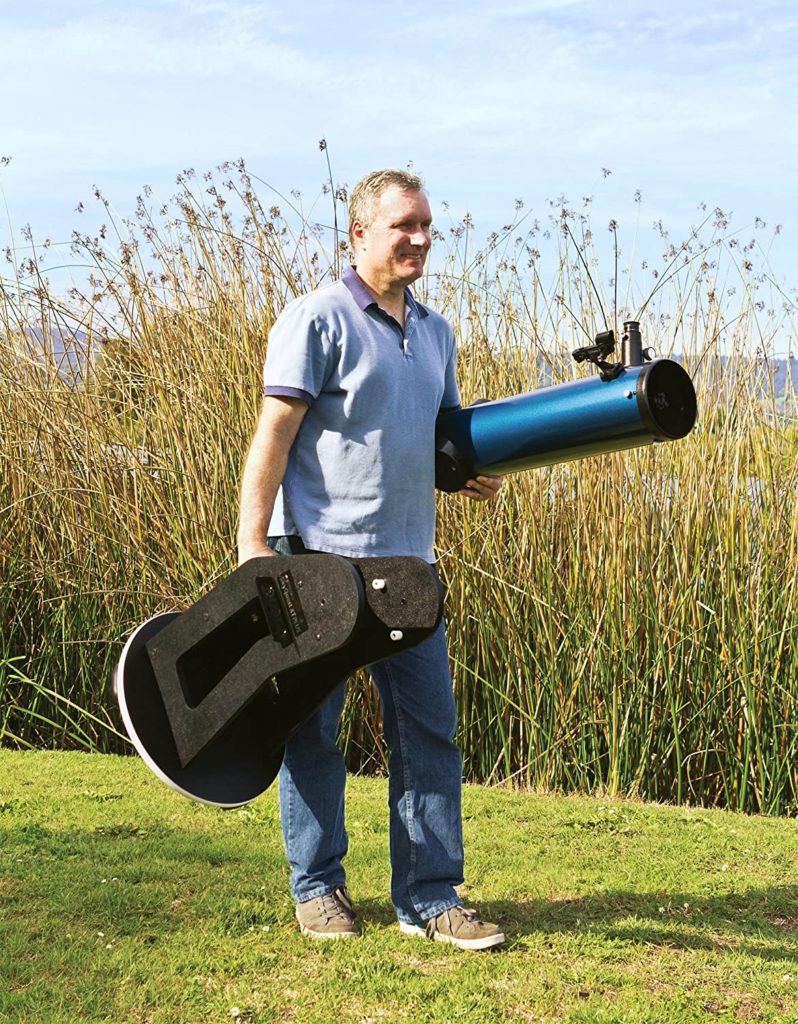
A white trim band around the round base of the XT6 Plus base enhances visibility in the dark.
An eyepiece rack is included that can hold up to three 1.25″ eyepieces, making it easy to store and swap between different oculars to vary the magnification of your observations.
The optical tube of the XT6 Plus, which sports an attractive “twilight blue” metallic finish, houses a 150mm parabolic (5.9″) mirror with enhanced-reflectivity (94%) aluminum coating for superior light transmission compared to standard mirrors.
These impressive optics are not just perfect for a professional astronomer but it also makes it one of the best telescopes for adults who are looking to fulfill their love for astronomy.
Its 1200mm focal length (f/8) provides this telescope with extraordinary magnifying power.
With the help of its included 10mm Sirius Plossl eyepiece you can easily study the Moon’s cratered surface or Jupiter’s cloud bands at 120x.
Pros:
- Affordable and budget friendly 6” telescope
- Redesigned base with weight saving cutouts
- Attractive “twilight blue” metallic finish
- Easy, tool-free collimation adjustment
- Highly visible white trim on base to work around in the dark
Cons:
- Few main components are made of plastic
- Not for astrophotography
Best Reflector Telescope
Orion 09007 SpaceProbe
- Type: Reflector
- Aperture: 130 mm(5.1″)
- Focal length: 650mm
- Focal Ratio: f/5
- Mount: Equatorial
- Eyepiece: 25mm, 10mm
- Magnification: 26x, 65x
- Weight: 24.2 lbs.(11 kg)
- Our Rating: 9/10
Prices pulled from the Amazon Product Advertising API on:
Product prices and availability are accurate as of the date/time indicated and are subject to change. Any price and availability information displayed on [relevant Amazon Site(s), as applicable] at the time of purchase will apply to the purchase of this product.
The Orion SpaceProbe 130ST Newtonian Reflector is an excellent and one of the best reflector telescopes for adults deep space viewing. It is well-suited for both beginners as well as intermediate stargazers.
The SpaceProbe 130ST is a 130mm f/5 Newtonian reflector telescope.
This 5.1″ aperture reflector telescope gathers an ample amount of light for great views of the planets and Moon, as well as brighter galaxies, nebulas, and star clusters
The telescope also comes with tools to help you assemble the product, and two eyepieces: 10mm for 65x, and a 25mm for 26x magnification, respectively.
The quick set-up and ease of use makes the SpaceProbe 130ST EQ a very versatile telescope which the whole family can enjoy.
This Orion space probe telescope also boasts a short 24″ long optical tube design which enhances its portability, while the 130mm optical diameter, and the 650mm focal length are in perfect balance with the f/5.0 focal ratio.
In addition, it possesses design features, such as a parabolic mirror and a specially designed holder for the secondary mirror, that focus the light captured by the aperture and use it to sharpen the images produced by the scope, even with its shorter tube.
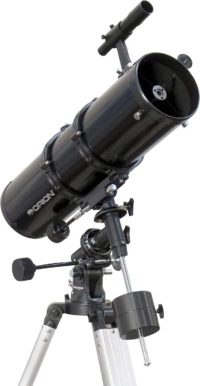
The included aluminium tripod is very sturdy, and also includes an accessory tray that can be very useful when you are outdoors in the dark and need a place to organize your accessories neatly.
The equatorial mount is perfectly built and allows manual slow-motion tracking of celestial objects as they move across the sky.
The mount can also be upgraded at a later time to a motorized option that tracks objects automatically, so that’s a nice option to have and definitely a plus if you are using the Orion SpaceProbe 130ST for astrophotography.
Just like many other similar products, the Orion 09007 also comes with Orion’s Starry Night software, which is very useful for beginners, and has the added benefit of alerting the user of upcoming celestial events.
Short 24″ long optical tube design for easy portability and fast f/5 focal ratio for pleasing wide-field performance makes the SpaceProbe 130ST EQ a very versatile telescope the whole family can enjoy
Pros:
- Nice set of accessories
- Can be upgraded to have motorized tracking
- Comes with an Equatorial mount and a versatile tripod
- Easy to assemble and transport
Cons:
- Plastic focuser and mount parts
- Somewhat confusing instructions
Best GoTo Telescope
Celestron – NexStar 5SE
- Type: Schmidt-Cassegrain
- Aperture: 125mm (5″)
- Focal length: 1250mm
- Focal Ratio: f/10
- Mount: Computerized Alt-az
- Eyepiece: 25mm, 50x
- Weight: 17.6lb (7.98kg)
- Our Rating: 9/10
Prices pulled from the Amazon Product Advertising API on:
Product prices and availability are accurate as of the date/time indicated and are subject to change. Any price and availability information displayed on [relevant Amazon Site(s), as applicable] at the time of purchase will apply to the purchase of this product.
Celestron’s NexStar 5SE is popularly bought and recommended as the best GoTo telescope for adults.
The Celestron NexStar 5 SE is a top Schmidt-Cassegrain telescope with an aperture of 5 inches that provides accurate images of the celestial bodies, with the touch of a button.
NexStar’s technology includes a database of almost 40,000 celestial bodies to see and learn about. With this NexStar telescope, you will go from amateur to pro in no time.
With the help of a DSLR and a computer, you can even take the time exposure video remotely.
As an amateur if you want to show off your budding talents to your friends and family then this is the best telescope for you.
You can easily shoot beautiful time exposure video of solar or lunar eclipse and enjoy it with your friends and family,
Setting it up is easy as you will not need any tools to set it up, and you can do it in a couple of minutes.
After entering the Date, Time and GPS location (you can get in your mobile app) you just have to point the telescope to the three brightest stars in the sky, rest is taken care by StarAlign technology built in the telescope.
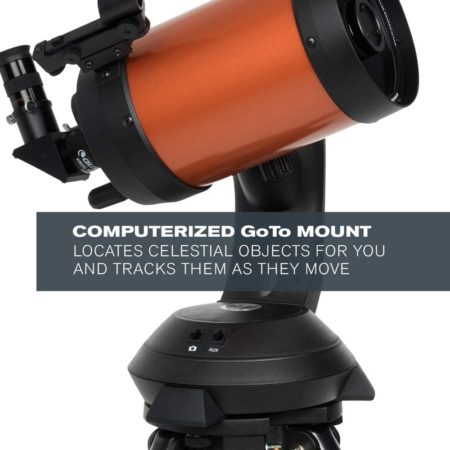
The design of the Celestron NexStar 5 SE is also very practical, with its fork arm design and sturdy steel tripod.
The 5SE comes with a single 25mm 1.25” Plossl eyepiece which provides 50x magnification.
The scope is designed with amateurs in mind as it is small, light, and easy to transport from place to place and easy to set up in order to provide an excellent stargazing experience.
You can even dismantle it into its separate components and take it with you on your expeditions.
Due to its erect image lens technology, it is both good for celestial viewing as well as equatorial viewing such as bird watching, enjoying the view of nature, mountains etc.
Pros:
- Perfect for amateur astronomers since the automatic GoTo mount with a database of over 40,000 celestial objects
- Highly portable – fits easily in the back of a normal car
- Can be used with a camera
- 2-year limited warranty
Cons:
- Short battery life
- Too light for deep space photography
Best For The Moon
Orion StarBlast II 4.5
- Type: Reflector
- Aperture: 114mm (4.5″)
- Focal length: 450mm
- Focal Ratio: f/4
- Mount: Equatorial
- Eyepiece: 25mm, 10mm
- Magnification: 18x, 45x
- Weight: 20.7 lbs.(9.4 kg)
- Our Rating: 9.4/10
Prices pulled from the Amazon Product Advertising API on:
Product prices and availability are accurate as of the date/time indicated and are subject to change. Any price and availability information displayed on [relevant Amazon Site(s), as applicable] at the time of purchase will apply to the purchase of this product.
The StarBlast II 4.5 EQ is one of the best reflector telescope for adults which also the whole family can enjoy, thanks to its great optics, convenient portability, and easy-to-use operation.
Views of everything from the Moon and planets to distant objects like star clusters and galaxies appear bright and clear through this amazing telescope.
It works amazingly well with the included Expanse telescope eyepieces which yield a very wide 66° apparent field of view that allows you to see distant deep space objects as well as moon and planets.
The included 25mm Sirius Plossl eyepiece provides 18x power magnification, while the 10mm Sirius Plossl eyepiece bumps up the power to 45x magnification. The 25mm is a great eyepiece to begin observing sessions with, since it provides a large window of night sky for you to view.
The telescope’s combination of short 450mm focal length and sizable 4.5″ aperture means the StarBlast II 4.5 EQ will provide brighter views at any magnification compared to longer focal length telescopes, which makes it easier for everyone, and especially beginners, to locate interesting sights in the night sky.
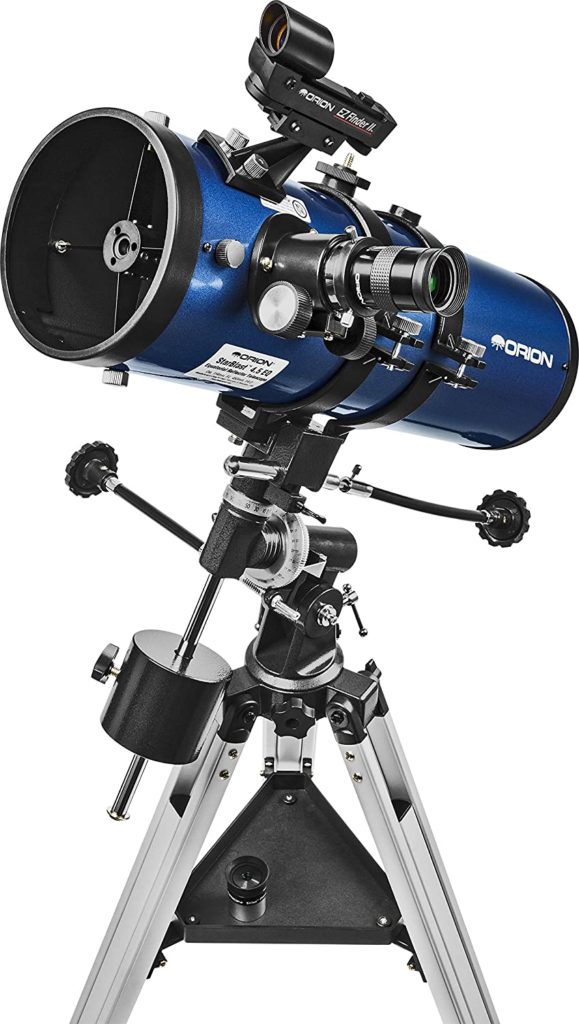
The StarBlast II sits inside two felt-lined tube rings that bolt onto the EQ-1 mount’s top plate – larger/more expensive equatorials use a Vixen dovetail and saddle which is slightly more convenient, but the simple system used with the StarBlast II works just fine.
Setting up and using the EQ-1 is pretty easy – just level the tripod, put the mount/scope together, balance the scope on both axes, and roughly line up the mount’s polar axis with Polaris.
Thanks to this design, it’s easy for anyone in the family to manually track a celestial object using slow-motion control cables. You can even add an optional electronic motor drive (sold separately) to the EQ-1 equatorial mount so it can track objects automatically once you’ve centered the object in the telescope eyepiece.
Pros:
- Wide field of view
- Lightweight and portable
- Easy to use
- Compatible with high-quality accessories
- Suitable for astrophotography
- Great for beginners and families with children
- Sturdy equatorial mount
Cons:
- No finder scope
- Not suitable for use in daylight
Best For DSOs
Sky-Watcher Flextube 200
- Type: Newtonian Reflector
- Aperture: 203mm (8”)
- Focal length: 1200mm
- Focal Ratio: f/6
- Mount: Dobsonian
- Eyepiece: 25mm, 10mm
- Weight: 50 lbs.(22.7 kg)
- Our Rating: 9.6/10
Prices pulled from the Amazon Product Advertising API on:
Product prices and availability are accurate as of the date/time indicated and are subject to change. Any price and availability information displayed on [relevant Amazon Site(s), as applicable] at the time of purchase will apply to the purchase of this product.
The 8ʺ dobsonian is an f/5.9 Newtonian, manufactured by Suzhou Synta Optical Technologies (Synta), the same company that owns Celestron. Synta also builds Orion’s XT and XX Dobsonians. The mirrors are made of borosilicate glass, also known as Pyrex, which expands far less with expansion and contraction than plate glass.
Sky-Watcher 8″ Collapsible Dobsonian Telescope features an elegant truss tube design that was carefully engineered to combine ease of use, extreme portability and consistent performance in an affordable package.
Unlike other truss tube designs, the Sky-Watcher Collapsible Dobsonian does not need to be disassembled between uses.
It transports as two compact pieces that can be assembled and ready to use in minutes. It is easy to collimate once set up, and it holds its collimation throughout the viewing sessions.
It is essentially a Dobsonian style Newtonian with a large 8″ aperture which is ideal for beginners who can invest a fair amount as well as professionals.
The telescope comes with a great focal length of 1200mm and with a focal ratio of f/6.
The Sky-Watcher 10″ Collapsible Dobsonian features a 2″ single speed Crayford style focuser and comes with a 1.25″ adaptor.
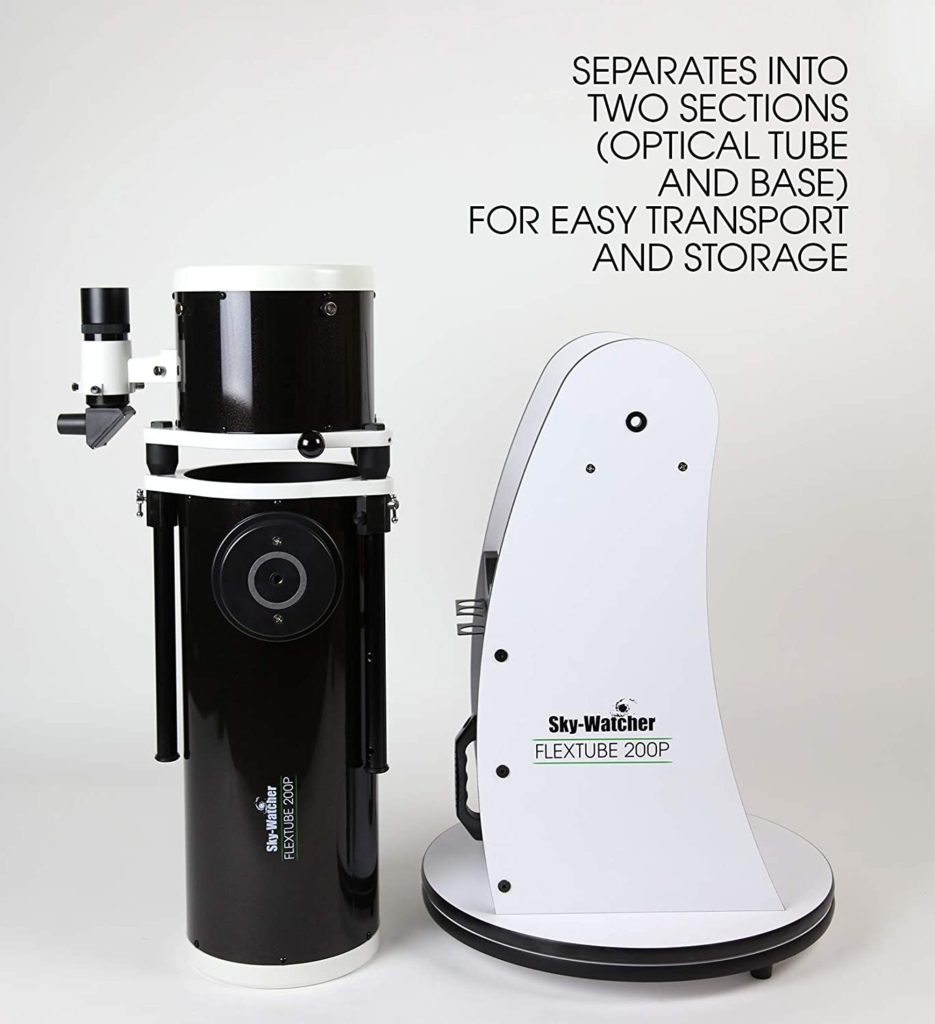
25mm and 10mm 1.25” super Plossl eyepieces are included. Metal construction, captive recesses on the barrels and rubber fold-down eye-cups make these good quality eyepieces that are certainly adequate to get you started.
This is one of the best telescope for adults for DSOs as it has a low-hassle OTA design which is not only simple in construction and use but it also provides the viewer with maximum light for viewing deep space objects without any aberrations or blurriness.
The Sky-Watcher 8″ Dob utilizes quality components throughout.
On each parabolic primary mirror, and elliptical diagonal mirror aluminum is vacuum deposited to the front glass surface and then over coated with hard quartz. Additional layers of Titanium Dioxide and hard quartz are then applied.
The mechanical and structural components of the OTA exhibit rigid construction and outstanding stability.
The mount construction is sturdy and rigid. Mount design, while simple, facilitates smooth motions about both axes.
The Sky-Watcher 8” comes with quality accessories that enhance the observer’s viewing experience.
Pros:
- Easy to transport due to collapsible tube design
- Focuses very accurately
- Easy to use
- Can be used by beginners & professionals
- Viewfinder helps in easy spotting of objects
- Built with high quality materials
Cons:
- Doesn’t come with a Barlow lens
- Needs a light shroud
Best Portable Option
Celestron – 70mm Travel Scope
- Type: Reflector
- Aperture: 70mm (2.8″)
- Focal length: 400mm
- Focal Ratio: f/5.7
- Mount: Alt-az
- Eyepiece: 20mm, 10mm
- Magnification: 20x, 40x
- Weight: 4.2 lbs (1.9 kg)
- Our Rating: 9/10
Prices pulled from the Amazon Product Advertising API on:
Product prices and availability are accurate as of the date/time indicated and are subject to change. Any price and availability information displayed on [relevant Amazon Site(s), as applicable] at the time of purchase will apply to the purchase of this product.
This telescope works great considering the fact that it is an inexpensive, portable scope. It provides wide, clear views of the sky that compare with much more expensive models.
The aperture performs surprisingly well given its size, and will most likely suit your needs given that it is a small, portable and one of the best portable telescope to observe the night sky.
The Travel Scope also comes pre-assembled and ready-to-use, so you can just grab it and go.
Its an easy to use and easy to set up telescope and you don’t have to exert a lot of effort on the installation of this travel scope. Moreover, you don’t even need any tools or equipment to assemble the scope before using it.
The 2.76 inch aperture is well-suited for the purpose of this home telescope and provides bright and crisp views given its size.
All of its optical components are glass coated for an efficient performance. Nevertheless, the light weight tripod is readily adjustable made from pre assembled aluminum and silver finish.
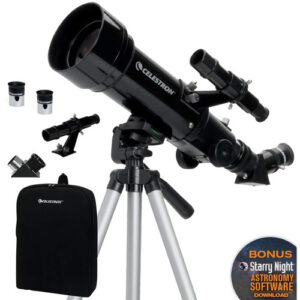
Incorporating a focal length of 400 mm, this device allows you to see clearly the rings of Saturn or the craters of the Moon. It should give you the magnification you need to spot the terrestrial objects you’re looking for in the night sky.
It is compactly built with the 70 mm refractor including two eyepieces used for high and low powered purposes. Nevertheless, the 20 mm eyepiece possesses 20x magnification while the 10 mm eyepiece has 40x magnification.
Also included is Sky X software, which allows you to learn the basics of astronomy and how to use your new telescope. Sky X is a great addition to any telescope and is an excellent tool to help beginners.
It features a smooth functioning altazimuth mount for easy location and shooting over several celestial bodies.
It is also suitable for astrophotography as it comes with a 2.5-degree field of view for greater scope and to enhance the picture quality that will be taken.
The Travel Scope is easy enough for any family member to use at home, it’s also a great telescope for more experienced astronomers will also be able to make great use of its features.
Pros:
- Easy to Use
- Perfect for home use
- Lightweight and highly portable
- Affordable Price
- Excellent optics
- Dual powered eyepieces
- Simple assembly
Cons:
- Shaky tripod
Best For Astrophgotography
Celestron – NexStar 127SLT
- Type: Schmidt-Cassegrain
- Aperture: 127mm (5″)
- Focal length: 1500mm
- Focal Ratio: f/12
- Mount: Computerized Alt-az
- Eyepiece: 25mm, 9mm
- Magnification: 60x, 167x
- Weight: 18.0 lbs.(8.2 kg)
- Our Rating: 9.6/10
Prices pulled from the Amazon Product Advertising API on:
Product prices and availability are accurate as of the date/time indicated and are subject to change. Any price and availability information displayed on [relevant Amazon Site(s), as applicable] at the time of purchase will apply to the purchase of this product.
The Celestron NexStar 127SLT is an entry-level GoTo telescope designed for anyone looking for a reliable telescope with which to enjoy the nighttime sky.
The telescope features a 127mm aperture and Celestron’s SkyAlign technology, this telescope offers consumers good views. In addition, the telescope’s single fork arm and simple design make it easy to set up and use.
The scope’s focal length is 1500mm, and it has a focal ratio of f/12. As far as eyepieces are concerned, each Celestron NexStar 127 SLT telescope comes with a 25mm eyepiece and a 9mm eyepiece, having a maximum magnification of 167x with the default 9 mm eyepiece.
The Celestron NexStar 127 SLT telescope stands on top of a motorized Altazimuth mount, which can be controlled via the provided digital hand controller.
Alternatively, the mount can be hooked to a computer for increased precision.
With preassembled, adjustable stainless steel tripods, and quick release fork arms and tubes, the NexStar 127 SLT telescope can be set up in a matter of minutes with no tools required.
The 127 SLT with its large aperture is great for viewing the surface of the moon, phases of Venus, rings of Saturn or Jupiter and its four largest moons, and other deep-space objects.
The Celestron NexStar 127SLT is also the best astrophotography computerized telescope for adults under on our list.
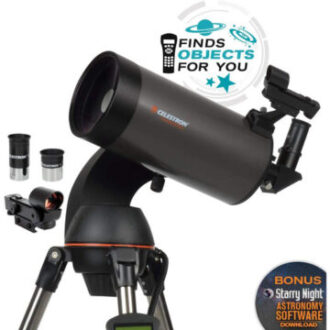
The Celestron NexStar GoTo mounts are powered by eight AA user-supplied batteries, or an optional AC adapter, making them perfect as a travel telescope.
With Celestron’s SkyAlign Technology, aligning your telescope is fast and easy. Simply input the date, time and location (the CPC models have built-in GPS that does this for you) and then align the telescope to three bright stars of your choosing.
You do not need to know the names of the stars, you can even pick the moon or bright planets. The NexStar computer system will automatically figure out which stars were chosen and then align the telescope.
The 127SLT’s diagonal is a prism, and a nice one at that – unlike the cheap diagonals supplied with many entry-level scopes which are cheap mirrors that aren’t very flat, which tend to offer dim and fuzzier images.
Pros:
- Super optical construction
- Very easy to operate with
- Compact and portable design
- Included needed additional accessories
- Suitable for lunar/planetary astrophotography
Cons:
- 8 AA batteries required but not included
- Tripod can be more stable
Best For Planets & Galaxies
Celestron – 114LCM
- Type: Reflector
- Aperture: 114 mm(4.5″)
- Focal length: 1000mm
- Focal Ratio: f/8.8
- Mount: Motorized; Alt-Azimuth
- Eyepiece: 25mm
- Magnification: 40x
- Weight: 15 lbs. (6.80 kg)
- Our Rating: 9/10
Prices pulled from the Amazon Product Advertising API on:
Product prices and availability are accurate as of the date/time indicated and are subject to change. Any price and availability information displayed on [relevant Amazon Site(s), as applicable] at the time of purchase will apply to the purchase of this product.
The Celestron 114LCM 114mm f/9 Computerized GoTo Reflector Telescope features a 114mm diameter parabolic primary mirror that is coated with highly-reflective aluminum to allow for detailed observation of the Moon and planets, with the ability to reach outside our solar system and view binary stars, clusters, galaxies, and nebulae.
The 114LCM consists of an optical tube with a 4.5-inch mirror and a focal length of 1000mm giving a focal ratio of f/9. It has a basic rack and pinion focuser that takes 1.25-inch eyepieces: 25mm and 9mm eyepieces are provided giving magnifications of 40x and 111x.
The Celestron 114LCM has over three and a half times the light gathering capacity of a typical 60mm starter scope. That means visibly brighter deep space images and the ability to see many more faint objects than a 60mm scope could ever hope to show.
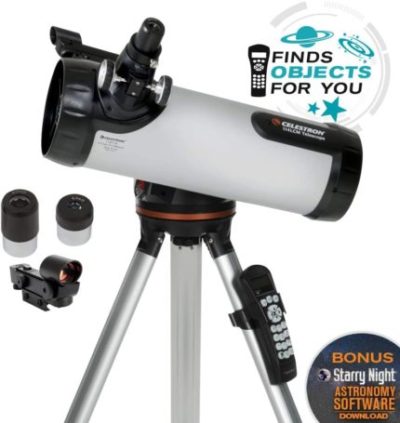
It has 90% more resolution than a 60mm scope as well, to let you see more sharper and detailed views of the Moon, planets, binary stars, and star clusters.
A built-in StarPointer red dot finder helps to aim the telescope, especially during the alignment phase.
The tube is attached to the motorised base via a Vixen-style mounting bar that connects to the aluminium tripod using a bolt on the underside.
The Celestron 114 LCM is one of the best telescopes for viewing planets and galaxies and it comes with a standard StarPointer red dot finder and an extremely short orange anodized aluminum Vixen style dovetail.
The NexStar+ LCM hand controller lets you control, align and operate the telescope. It has a database of 4,000 targets including Solar System, Messier, NGC and Caldwell objects, along with double stars, variable stars and more.
The telescope features a single fork arm altazimuth design with pre-installed enclosed dual DC servo motor drives.
A compartment in the drive base accepts eight user-supplied AA batteries for powering the telescope. An optional AC adapter and rechargeable battery pack are available to conserve battery life.
The preassembled tripod has aluminum legs to damp vibrations quickly. The center leg brace holds a convenient no-tool quick-release accessory tray to keep your eyepieces and accessories.
Pros:
- Beginner friendly GoTo telescope
- Decent optics
- Free download of astronomy software programs for an interactive sky simulation
- Multiple accessories
Cons:
- Weak battery life
- Calibration can take some time
Best Refractor Telescope
Gskyer Telescope
- Type: Refractor
- Aperture: 90mm(3.5”)
- Focal length: 600mm
- Focal Ratio: f/6.7
- Mount: Altazimuth Mount
- Eyepiece: 25mm,10mm,5mm
- Magnification: 24x, 60x, 120x
- Weight: 18 lbs. / 8.2 kg
- Our Rating: 9.2/10
Prices pulled from the Amazon Product Advertising API on:
Product prices and availability are accurate as of the date/time indicated and are subject to change. Any price and availability information displayed on [relevant Amazon Site(s), as applicable] at the time of purchase will apply to the purchase of this product.
Gskyer is a German company and is one of the best telescope brands in the world, known to produce high-quality telescopes.
This is a great starter telescope for the explorer who intends to take their telescope with them on their journeys. Hiking, camping, and even moonlit fishing trips will be more fun when you have this telescope along with you.
The Gskyer AZ90600 is one of the best refractor telescopes for the money. If you live in the city and you aren’t able to see much of the sky due to light pollution, you’ll want a telescope like this that’s easy to carry with you.
The 90 millimeter aperture is perfect for viewing most of the things you’d want to view, and all of the glass optics are coated to automatically adjust the brightness of the stars to a level safe and comfortable for observation.
Though this is a beginner telescope, you can use it to observe the moon, stars, meteors, and planets. The telescope offers great clarity, allowing you to see the surface of the moon, the rings of Saturn and the moons of Jupiter.
It also comes with a smartphone adapter, which allows you to use the phone as a screen, or as a camera to take great pictures.
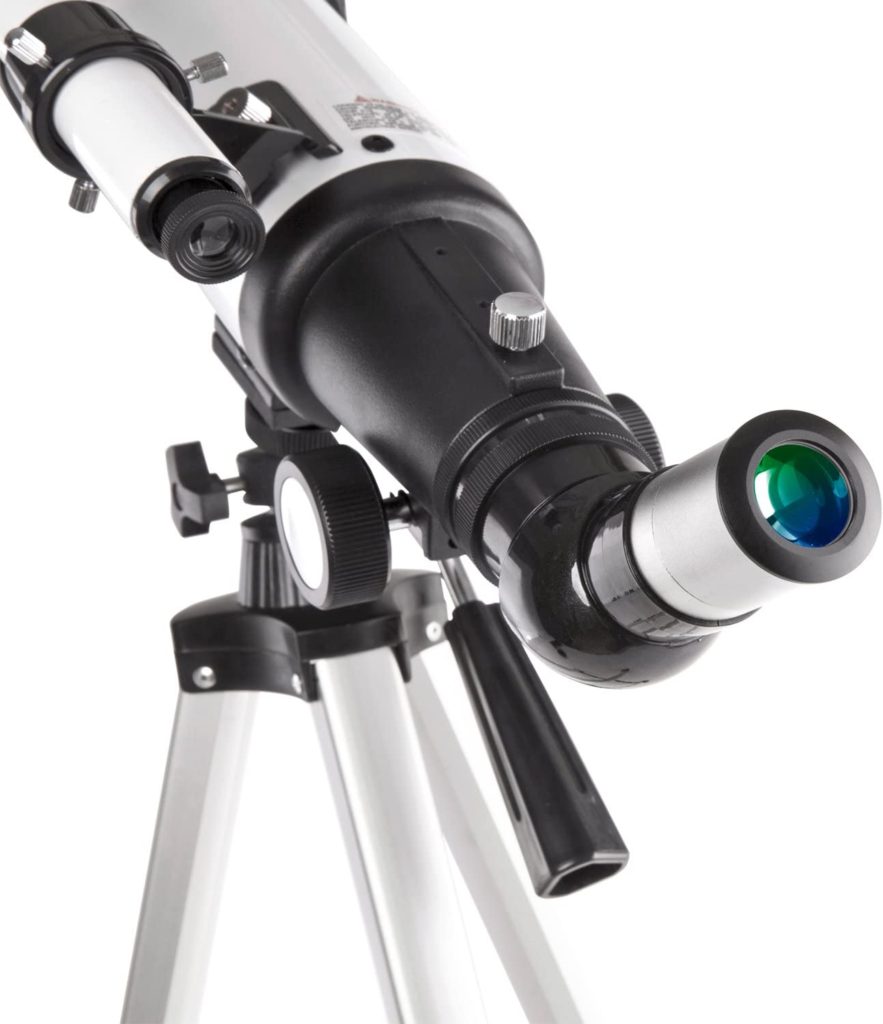
Plus, this model is extremely easy to assemble and doesn’t require any calibration. If you’re a telescope beginner, you won’t have to worry about any tricky steps or complicated tests.
The Gskyer AZ90600 comes with an adjustable tripod. This adjustable aluminium tripod offers the viewer many different viewing positions. The height of the aluminum tripod can be adjusted from about 31.5-inch to 49-inch.
It’s 90mm (3.5″) aperture gives bright, sharp images for both land and celestial objects.
Whether you’re viewing the rings of Saturn, the moons of Jupiter, surface details on the Moon, or terrestrial objects, the Infinity 90 Refractor allows the amateur astronomer to explore the solar system and beyond.
Pros:
- Large aperture
- 3 eyepieces
- Smartphone adapter
- Easy to assemble and use
- Adjustable tripod
- Perfect travel telescope
Cons:
- Good for viewing planets, stars not so much
Best Telescope For Adults; Buying Guide
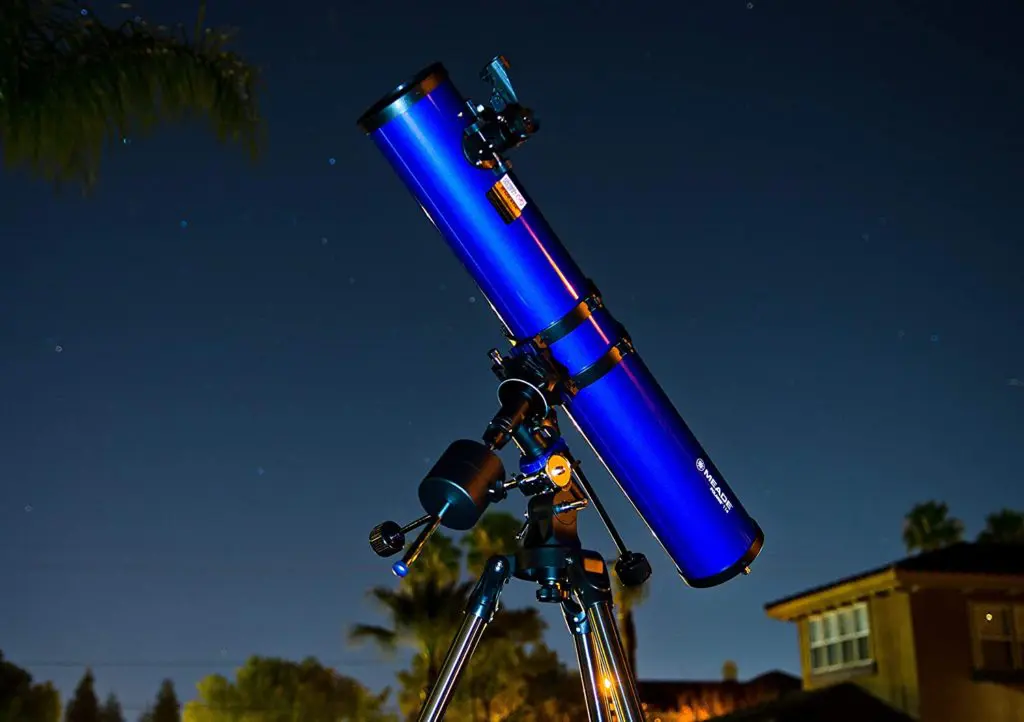
The ability to see deep into the cosmos has a profound effect on most people, and fortunately, it’s much easier to do than you might think.
For a breathtaking planetary viewing experience every time, it is important to make sure you’re purchasing a quality product – not something you’ll find at most department-stores.
Here is a comprehensive telescope buying guide which will explain the importance of all the parts of a telescope and the important features that you should look for when purchasing a good telescope for adults.
Features To Consider When Choosing A Good Telescope For Adults
Aperture
Aperture might be the most discussed component of a telescope. The aperture is the diameter of the telescope’s mirror or lens, and it determines how much light the telescope lets in and, in turn, how sharp the image appears.
One mistake that beginner adults might make when choosing their first telescope is thinking that bigger aperture is always better when it comes to aperture. Bigger aperture generally means a higher price and a bulkier telescope.
As a thumb rule – a refractor telescope should have a 6-inch (150 mm) mirror at least while a reflector telescope requires a 4-inch lens.
Focal Ratio
Focal ratio is the focal length divided by the objective diameter. A long focal ratio implies higher magnification and narrower field of view with a given eyepiece, which is great for observing the moon and planets and double stars.
For such objects, a focal ratio of f/10 or more is ideal. But if you want to see wide views of star clusters, galaxies, and the Milky Way through your best telescope for beginner adults then a lower focal ratio is better. You get less magnification, but you see more of the sky. Wide field telescopes have a focal ratio of f/7 or less.
Focal Length
Focal length refers to the distance between the primary lens/mirror and the point where the object is brought into focus.
The focal length is important, because it’s a factor in how well a telescope magnifies objects. To figure out the magnification, divide the focal length of the telescope by the focal length of the eyepiece: If you have a 25-millimeter eyepiece and a refractor of 1000 mm, the magnification is 40 power, written as 40x (or, 1000 / 25 = 40).
To avoid fuzziness, make sure to magnify a telescope to no more than twice the aperture of your telescope in millimeters (or 50 times the aperture in inches).
Magnification
Any telescope can provide almost an infinite amount of magnifications – this is because you can switch out a telescope’s eyepieces and therefore you always have new options – however two major features will limit your potential to magnify and object further: the telescope’s aperture and atmospheric conditions.
For your given aperture length, the higher you magnify typically the darker your image will be – and therefore harder to see its details.
The best magnification setting is actually 50 times your telescope’s aperture in inches. For instance, a high-quality 4-inch scope at 100mm shouldn’t be pushed beyond 200x magnification, otherwise what you see through it would not be of good quality.
Eyepieces
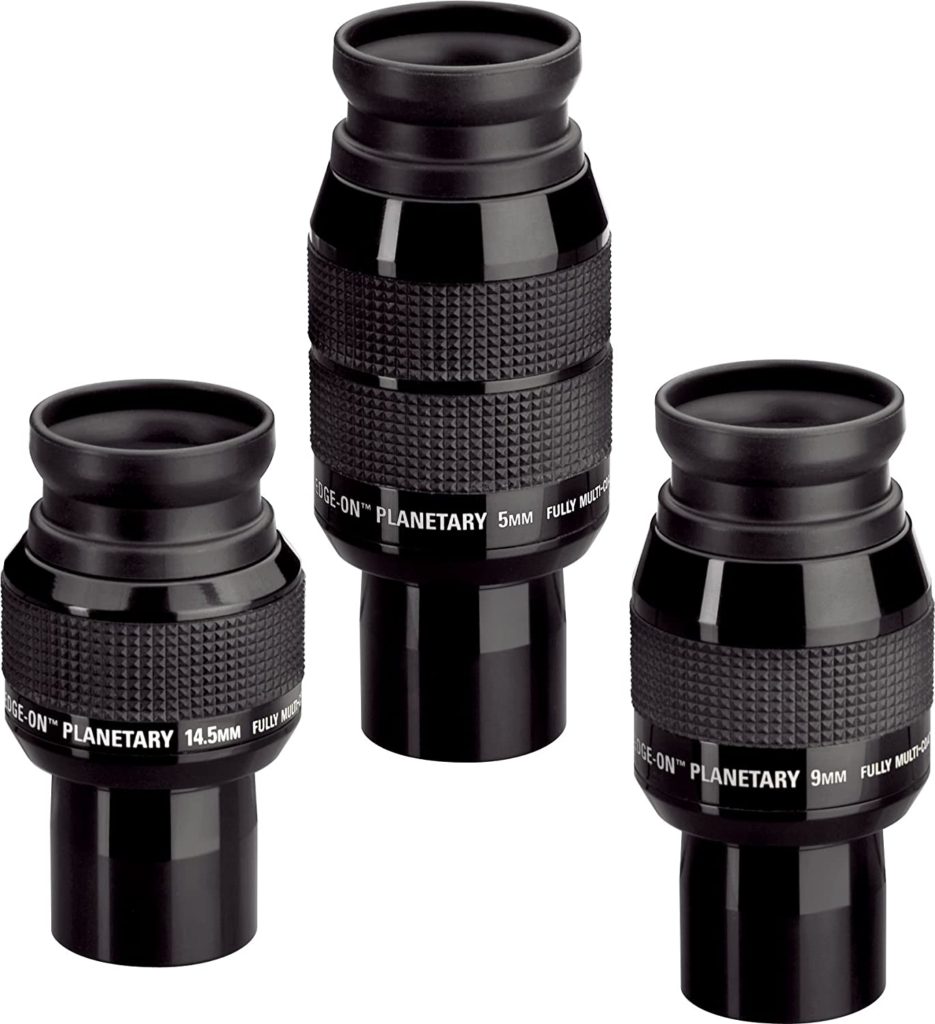
Eyepieces determine the magnification and field of view of a telescope. Different eyepieces are used to view different objects.
Some objects, such as nebulae and star clusters, appear quite large and are best viewed at low magnifications (which give a wider field of view), whereas planets appear very small and are normally viewed with high-magnification eyepieces.
Most telescopes come supplied with one or two eyepieces. Ideally, you’d like to have a set that spans a range of magnifications.
You can expect to spend anywhere from $40 to $250 on a good eyepiece.
Barlow Lens
A Barlow lens is also worth considering: it multiplies each eyepiece’s power by two or three times, effectively doubling your eyepiece collection.
A Barlow lens will connect directly to your eyepiece. The most common Barlow is the 2x Barlow. A 2x Barlow will double the magnification of the eyepiece it is attached to.? For example, if you were using a 20mm eyepiece on a telescope with a 1000mm focal length, you would have 50x magnification.
If you attach a 2x Barlow lens to that eyepiece you will double the effective magnification of that eyepiece to 100x.
Types Of Telescopes
Telescopes come in all shapes, sizes, and functions. There is a telescope type for each and every band of electromagnetic radiation from gamma rays to light to radio. However, the optical types are all you need.
Optical telescopes may only work for visible light, but will let you see just about everything nature has to offer. There are three types of optical telescopes on the market and each has its own advantages and disadvantages.
Refractor Telescopes are the original, earliest type of telescopes. Basically just a long tube with lenses on the ends, these small telescopes gather and concentrate light by passing the light through the common focal point of the two lenses.
They are relatively cheap and offer the best bang for your buck. Refractors give you clear, detailed, and highly magnified images, and there is no obstruction to block any of the light.
Reflector Telescopes use mirrors instead of lenses to gather light and produce clear and magnified images. A large concave mirror focuses the light, and a much smaller secondary mirror redirects the light into the eyepiece.
With all their main optical equipment on one end, reflectors can get quite large.
Dobsonian telescopes fall under reflector telescopes (Newtonian reflector).
Cassegrain Telescopes are the best of both worlds. They combine a lens (like a refractor) with two mirrors.
They are a bit fancier in design and are usually more compact than the other two. They are, however, also the most expensive.
In spite of their high costs, these are the most popular scopes on the market.
Conclusion
Our top pick for the best telescope for adults is the Celestron – PowerSeeker 127EQ . The scope is Ideal for near and deep-sky observation and is best for beginner adults looking for a good telescope.
It features a respectable focal length and a large, parabolic mirror that produces detailed images of the Moon, clear views of the planets, and the ability to resolve bright distant objects such as nebulae and galaxies.
Our next best telescope for adults is a reflector – Celestron’s AstroMaster 130EQ 130mm f/5 Reflector Telescope features a 650mm focal length and an oversized parabolic mirror that produce detailed images of the Moon, clear views of the planets, and the ability to resolve distant objects such as nebulae and galaxies.
Celestron – NexStar 5SE Telescope is our pick for the best GoTo telescope for adults. The 5-inch aperture provides excellent light-gathering ability at an affordable price. You’ll get impressive views of the Moon and planets, along with deep sky objects like the Orion Nebula, while retaining a compact form factor.
Fully automated GoTo mount with a database of 40,000+ celestial objects automatically locates and tracks objects for you.
ABOUT US
We are a team of active amateur astronomers, here to help you with all your astronomy and science related needs – this is anything, from reviewing the latest telescopes to be released to talking about gravity and neurons. The Big Bang Optics was started because of our love for astronomy and to help others like us find the best telescope and accessories.
LEGAL DISCLAIMER
The Big Bang Optics is a participant in the Amazon Services LLC Associates Program, an affiliate advertising program designed to provide a means for sites to earn advertising fees by advertising and linking to Amazon.com. The Big Bang Optics also participates in affiliate programs with Clickbank and other sites. The Big Bang Optics is compensated for referring traffic and business to these companies.


